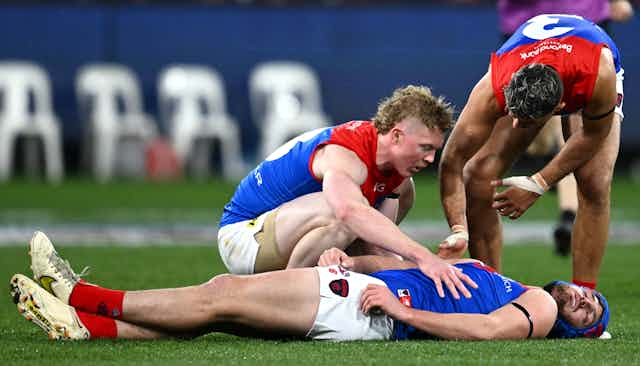The Australian Football League (AFL) recently announced it is “considering appointing independent doctors at all AFL games to assist club medical staff in identifying and assessing players for potential head injuries.”
The announcement came after recommendations of a coronial inquiry into the death of former AFL player Shane Tuck, who died by suicide in 2020.
A post-mortem examination of Tuck’s brain found an advanced case of Chronic Traumatic Encephalopathy (CTE), a neurodegenerative disease linked with repetitive head trauma.
CTE is a form of dementia which is more frequently diagnosed in people with exposure to repeated head trauma, like athletes in contact sports.
The governing bodies of these sports, including the multiple football codes in Australia, have been striving for several years to assure players, parents and the public that their games are safe to play.
Why are independent doctors needed?
One of the most significant concerns about concussion (otherwise known as a mild Traumatic Brain Injury or mTBI) is the potential for an athlete to incur serious neurological damage if they suffer recurrent brain injuries within a short period of time.
This is why many contact sport organisations around the globe and in Australia have developed exclusion protocols for concussed players, to prevent their brain from receiving more trauma while it is still recovering.
In Australia, mandatory exclusion periods vary between different sports. The AFL recently announced it would adopt the Australian Institute of Sport’s (AIS) recommendation for 21 days of exclusion from games and training for non-elite or “community” athletes.
The rules are different for players in the elite AFL and AFLW competitions, who are only required to sit out for 12 days post-injury.
The first step in this exclusion process is determining whether or not a player has sustained a brain injury. Currently, this decision is made by a club doctor – a licensed medical doctor who is employed by an AFL or AFLW team.
Concerns have been raised about the impartiality of club doctors, and the potential for their decisions to be knowingly or unknowingly influenced by a desire to see their club succeed.
The subsequent suggestion is, if independent doctors are employed by the AFL or AFLW, rather than the clubs, they would be better able to make a diagnosis without being influenced by coaching staff or other players.
With pressure comes risk
Being embedded in a high-performance sporting environment can influence people, including doctors, to adopt a win-at-all-costs attitude.
If the AFL and AFLW decide to adopt independent concussion doctors, not only will it relieve club doctors of some of their responsibilities regarding players’ brain health, it will also remove another key decision-making group from the process – coaches.
Some coaches are vocal opponents of removing coaching staff and club doctors from decisions about brain injuries. In the National Rugby League (NRL), where independent doctors have been employed since 2022, coaches Ricky Stuart and Wayne Bennett argue it is a sign the governing bodies do not trust coaching staff or club doctors.
However, the code argues it is not an issue of trust, rather it is about ensuring decisions on player welfare are made dispassionately by those who have specific training in the area.
It has been argued from performance, legal, and moral perspectives that care for athletes should be central to the practice of sport across all codes.
Indeed, some coaches have been major public advocates for this and there is no suggestion that coaches or clubs do not care for the health of their players.
However, the pressures of elite sport and the backgrounds and training of many coaches, particularly those who are former players, can create an environment where player health is seen as a reasonable sacrifice for high-performance and competitive success.
Removing doctors from this environment is intended to help them make more impartial decisions about concussions.
Read more: Here's what we know about CTE, the brain condition that affected Danny Frawley
Are independent doctors the right move?
The introduction of independent doctors is a step-change for the AFL rather than a fundamental shift.
The AFL’s approach to managing brain injuries is precisely that – it ‘manages’ brain injuries because the league, along with the people who manage other high-contact games, know that any significant reduction to the incidence of brain trauma would require fundamental changes to the way their sports are played.
Ultimately, the introduction of independent doctors is an exercise in tinkering, which will have no tangible impact on reducing the number of brain injuries sustained by elite players.
It also remains to be seen how the AFL might seek to introduce a similar system of concussion watchers for the hundreds of thousands of recreational footballers across Australia, who play the same games as their professional counterparts with far fewer eyes watching them.
It is also important to note that emerging evidence tells us the risk of developing a long-term neurodegenerative disease like CTE is most strongly related with repeated micro-concussions, which cannot be diagnosed by a doctor, independent or otherwise.
If the AFL and AFLW adopt independent doctors, it will be a positive move toward further prioritising player welfare, but it will not fix the concussion problem.

